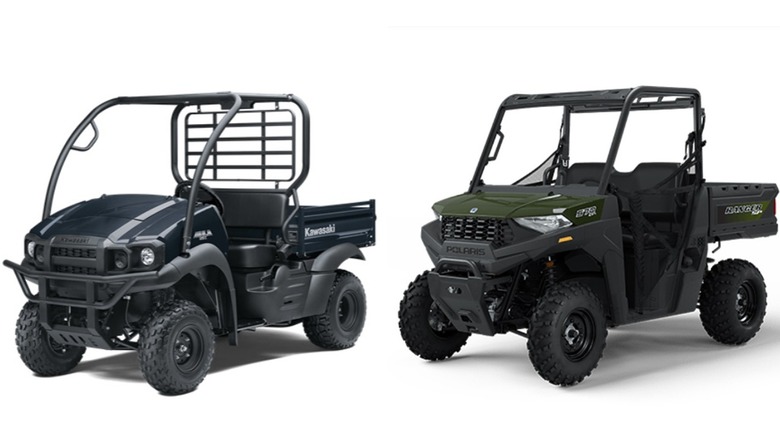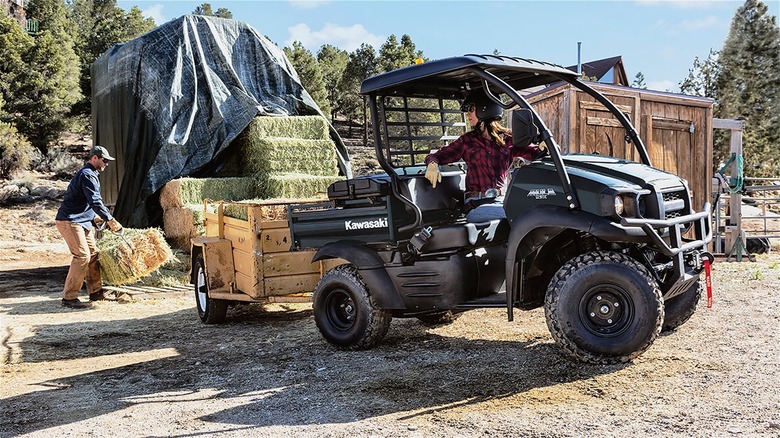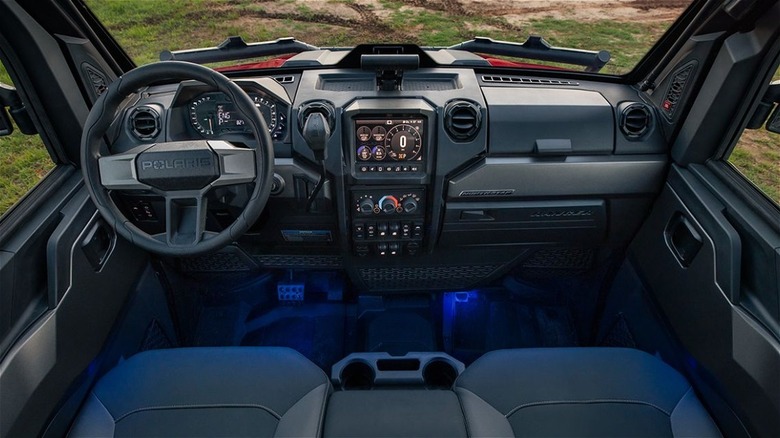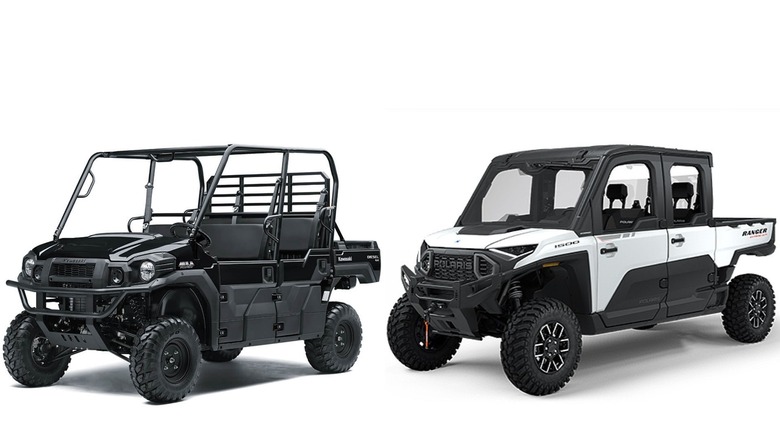Kawasaki Mule Vs. Polaris Ranger: What's The Difference Between These Popular UTVs?
The very first utility task vehicle (UTV), as they're known today, was launched in 1988 with Kawasaki's Mule (multi-use light equipment). Since that time, many manufacturers have jumped into the side-by-side market, with major players like Honda, Yamaha, Polaris, and Can-Am battling for market share. While Kawasaki might have been the first to introduce the modern UTV, Polaris made waves in 1999 with their release of the 6x6 Ranger. Fast forward to today, and these two colossal powersports brands are still duking it out with Kawasaki's Mule in one corner and the Polaris Ranger in the other. In terms of market share, 2023 figures show that Polaris is the leader, with Kawasaki placing fifth out of the top ten brands of off-road vehicles, per MotorcyclesData.com.
But for those comparing these models, there are several distinctions between them. The Kawasakis are more affordable in price and straightforward in their design, but the Polaris offers greater muscle and more advanced features.
The budget-friendly option
Price is an important consideration for most people when buying a UTV, and the Mule from Kawasaki has the upper hand over the Polaris Ranger. The most inexpensive choice with Kawasaki is the Mule SX (two-passenger), which starts at $8,299. There are an additional four variations for the Mule SX, which include the Mule SX 4x4, Mule SX 4x4 XC, Mule SX 4x4 FE, and the Mule SX 4x4 XC LE. With Polaris, the most affordable model starts with the Ranger SP 570, which has an MSRP of $11,499. There is one other trim available, the Ranger SP 570 Premium, which includes some additional features at $13,999. Interestingly, the Mule SX and all its variants are only available in a two-seat configuration, whereas the Polaris Ranger SP 570 comes with an optional four-seat model for $13,499.
On the top end, the difference in cost between the two brands becomes even more evident. Kawasaki offers the Mule Pro-DXT (three to six-passenger) side-by-side starting at $19,799. The costliest version is the Mule Pro-DXT FE EPS, designed for commercial usage, which starts at $19,999. Conversely, Polaris offers the Ranger XD 1500 NorthStar Edition Premium in a three-passenger version for $39,999 and a six-passenger configuration for $44,499. At the very top of the Ranger line is the XD 1500 NorthStar Edition Ultimate, with a six-passenger model priced at $49,499.
Simplicity versus features
In terms of technology, the Mule doesn't offer the same level of enhanced features that the Ranger does. The positive aspect of fewer high-end gadgets is that the Kawasaki is easier to figure out and may require less downtime during maintenance. On the other hand, the Polaris comes equipped with some highly attractive features you might enjoy. For example, the entry-level Mule SX doesn't come with 4WD, whereas the base Ranger SP 570, includes true on-demand all-wheel drive. The Mule SX with two-wheel drive is a less complex system with fewer controls, but reduced off-road prowess. However, the Ranger SP 570 has increased off-road capability and more controls, but more moving parts to maintain.
The cab showcases another example of the more basic nature present in the Mule versus the high-tech character of the Ranger. The more robust Kawasaki UTV model, the Mule Pro-DXT, still features a basic dash with tactile controls, a shifter, power outlets, and a small digital center display. The Ranger XD 1500 NorthStar Edition comes equipped with a combination digital-and-analog instrument cluster, a large center color display (with GPS capability), and full climate control settings for added comfort. While more basic from the factory than the Ranger, you can equip several top accessories for your Kawasaki Mule adding custom features important to you.
Power, payload, and towing capacity
While the Kawasaki is certainly a capable machine, head-to-head, the Polaris offers much more available brawn for tough tasks. Comparing the most basic models, The Mule SX comes with a 401cc engine, 399-pound bed capacity, and up to 1,100 pounds of towing muscle. Alternatively, the Ranger SP 570 utilizes a 567cc engine, allows for up to 500 pounds in the bed, and can tow 1,500 pounds.
On the top end, the Mule Pro-DXT offers a 993cc diesel engine that produces 38.3 lb-ft of torque, provides 999 pounds of payload (with three occupants), and can pull 2,000 pounds. The Polaris Ranger XD 1500 NorthStar Edition comes ready with a 1500cc engine producing the industry's highest 105 lb-ft of torque. You can stack the bed with up to 1,500 pounds of material and tow a massive 3,500 pounds behind the Ranger XD 1500 NorthStar.
Regarding unique options, the Kawasaki offers a diesel engine with its Mule Pro-DXT starting at $19,799, whereas Polaris doesn't offer diesel on the Ranger series. However, there is an option for an electric Polaris, called the Ranger XP Kinetic all-electric UTV, which starts at $29,999 and a comparative Mule isn't currently available. One advantage to the electric Ranger is its silent operation, which allows hunters to travel deep into the woods without spooking the animals.
Mule and Ranger: Which one to choose?
The answer to this question depends on your budget, performance requirements, and personal preference. Generally, if you're looking for a powerful UTV model that won't crush your bank account, the Kawasaki Mule is an excellent choice. If, however, you want the most robust power on the market due to some hefty projects on the farm, ranch, or job site and aren't sure the Mule can do it, go with the Polaris Ranger.
Regarding features and technology, if you have the mindset that more high-tech amenities mean more things to break, the Mule is a better option. But if you want additional choices, information, and capability, the more advanced Ranger has you covered. It really comes down to how often you'll use the Ranger's more cutting-edge tech. If you won't utilize enhancements like GPS navigation, HVAC climate control, and a 6,000-pound winch, like those found on the Ranger XD 1500 NorthStar Edition, opt for Kawasaki Mule, and save money. However, some off-roaders absolutely will take advantage of these additional features making the more costly Polaris worth the investment. For those still on the hunt for the right UTV, we also compared the Yamaha Viking vs. Kawasaki Mule, outlining the differences in key areas.




